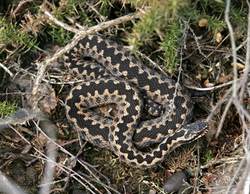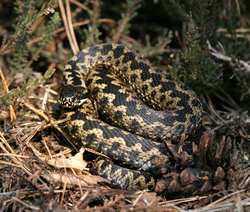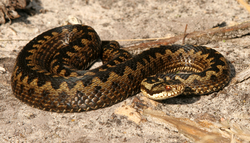21st May 2011
I attended the local Ratepayers Association ward meeting on the 12th May and gave an update of the Brickfields L.N.R. I happened to mention that I had regularly see Grass snakes and Slow worms and there were probably also Adders over Brickfields as well. I got the feeling, not all of those attending were happy! I have also mentioned these facts to people who visit as well; sometimes a look of horror is a response. I don’t set out to frighten or to get a shock reaction, but just to show how diverse in wildlife Brickfields is! So there are no Rattlesnakes, Cobra’s or Pythons waiting for you in Brickfields, no more then there are Alligators, Crocodiles and Piranhas lurking in the pond. So here are some facts about the only venomous snake in Britain.
The Adder: Scientific name: Vipera berus
Size: The male is around 60cm long, and the female is approx 75cm
Distribution: Found throughout England, Scotland and Wales.
Months seen: March to October. During the winter adders hibernate underground. The young are usually born around August.
Habitat: Adders are normally found on heathland or sand dunes. They can often be seen warming up their bodies (basking) in the sunshine.
Food: Mice, voles and lizards.
Adders can be recognised: ( see pictures below ) by the dark zig-zag pattern running down the length of their back, and by the dark V-shaped marking on the back of their head.
What people really worry about is being Bitten so......How common are snake bites?
N.H.S facts & figures. Each year, approximately 100 cases of adder bites are reported in the UK. Most bites occur between February and October, with the number of bites peaking during the summer months.
Adder bites can be painful but they are rarely serious. About 7 out of 10 adder bites only result in pain and swelling in the area that has been bitten. Since records began in 1876 there have only been 14 reported deaths as a result of adder bites, with the last death occurring in 1975!!
Adders sometimes bite without injecting any venom (toxins produced by the snake). This is called a ‘dry’ bite and may cause: mild pain caused by the adder’s teeth puncturing the skin, a little more than a wasp sting. If an adder does inject venom when it bites it can cause more serious symptoms including: Swelling and redness in the area of the bite, nausea (feeling sick) vomiting and feeling faint. So seek medical advice at once.
Adders bite in self-defence if they are disturbed or provoked. They don’t go out looking for humans or dogs to bite, in fact the total opposite, they don’t want to been seen or to be attacked. They will just slide away rather then be confronted.
I have not seen any Adders over Brickfields yet...The last one I saw in the wild, was last year, in the grounds of St. Georges Hospital, Hornchurch !
So if you want to find your own Adders, I will tell you how tomorrow !!
I attended the local Ratepayers Association ward meeting on the 12th May and gave an update of the Brickfields L.N.R. I happened to mention that I had regularly see Grass snakes and Slow worms and there were probably also Adders over Brickfields as well. I got the feeling, not all of those attending were happy! I have also mentioned these facts to people who visit as well; sometimes a look of horror is a response. I don’t set out to frighten or to get a shock reaction, but just to show how diverse in wildlife Brickfields is! So there are no Rattlesnakes, Cobra’s or Pythons waiting for you in Brickfields, no more then there are Alligators, Crocodiles and Piranhas lurking in the pond. So here are some facts about the only venomous snake in Britain.
The Adder: Scientific name: Vipera berus
Size: The male is around 60cm long, and the female is approx 75cm
Distribution: Found throughout England, Scotland and Wales.
Months seen: March to October. During the winter adders hibernate underground. The young are usually born around August.
Habitat: Adders are normally found on heathland or sand dunes. They can often be seen warming up their bodies (basking) in the sunshine.
Food: Mice, voles and lizards.
Adders can be recognised: ( see pictures below ) by the dark zig-zag pattern running down the length of their back, and by the dark V-shaped marking on the back of their head.
What people really worry about is being Bitten so......How common are snake bites?
N.H.S facts & figures. Each year, approximately 100 cases of adder bites are reported in the UK. Most bites occur between February and October, with the number of bites peaking during the summer months.
Adder bites can be painful but they are rarely serious. About 7 out of 10 adder bites only result in pain and swelling in the area that has been bitten. Since records began in 1876 there have only been 14 reported deaths as a result of adder bites, with the last death occurring in 1975!!
Adders sometimes bite without injecting any venom (toxins produced by the snake). This is called a ‘dry’ bite and may cause: mild pain caused by the adder’s teeth puncturing the skin, a little more than a wasp sting. If an adder does inject venom when it bites it can cause more serious symptoms including: Swelling and redness in the area of the bite, nausea (feeling sick) vomiting and feeling faint. So seek medical advice at once.
Adders bite in self-defence if they are disturbed or provoked. They don’t go out looking for humans or dogs to bite, in fact the total opposite, they don’t want to been seen or to be attacked. They will just slide away rather then be confronted.
I have not seen any Adders over Brickfields yet...The last one I saw in the wild, was last year, in the grounds of St. Georges Hospital, Hornchurch !
So if you want to find your own Adders, I will tell you how tomorrow !!

A fairly typical basking position for an adult male Adder. As usual, thick cover is close by the basking spot, in this case a gorse thicket.

The reward for hours spent searching for Adders can be sight of beautiful animals such as this adult, who was carefully caught and posed for this picture.

This male Adder has found a last shaft of sunlight for basking as evening sets. This demonstrates how Adders are drawn to direct sunlight.
 RSS Feed
RSS Feed